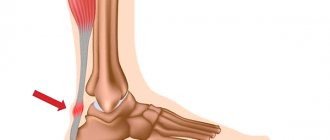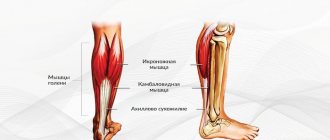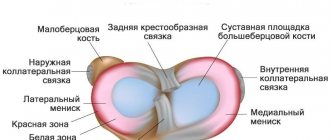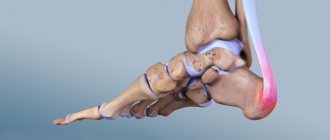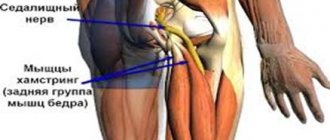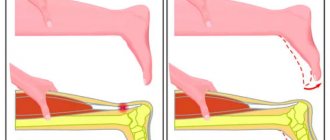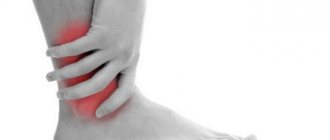The Achilles tendon is the strongest tendon in the human body. Formed by the fusion of the tendons of the gastrocnemius and soleus muscles. Its potential is to withstand a load of 350 kg. However, rupture of the Achilles tendon is not uncommon. Injury can occur when the tendon is overstrained or if there is an impact when the tendon is pulled during sports, work, a car accident, or a fall. Also, rupture of the Achilles tendon can occur as a result of previously obtained multiple microtears of its fibers. Most often, the rupture occurs in a place 5-6 cm above the heel tubercle.
The following degrees of Achilles tendon rupture are distinguished:
- Achilles tendon sprain – slight damage to the fibers;
- subtotal rupture of the Achilles tendon – partial disruption of the integrity of the fibers;
- total rupture of the Achilles tendon - complete disruption of the integrity of the fibers;
- separation of the Achilles tendon from the heel tubercle;
- degenerative and chronic injury of the Achilles tendon.
The risk of getting an Achilles tendon tear increases with long-term use of fluoroquinol antibiotics and improper treatment with glucocorticosteroid drugs.
Partial rupture of the Achilles tendon
Incomplete rupture of the Achilles tendon implies damage to only part of the fibers, while the tendon retains its function or does not lose it completely. However, partial rupture of the Achilles tendon is less common than complete rupture. Symptoms of partial damage are less pronounced than with a complete rupture: moderate pain, slight swelling, limited movements.
In turn, partial damage to the Achilles tendon can be mild to moderate. In the first case, up to 20% of the fibers are damaged, in the second – up to 50%. Treatment consists of immobilizing the ankle joint, prescribing anti-inflammatory drugs, physiotherapy and exercise therapy.
Diagnosis of the disease
Diagnosis of tendon rupture
How to detect damage to the ankle and ligamentous apparatus? To do this, the doctor conducts instrumental diagnostics, which allows an accurate diagnosis, assessment of the extent of the lesion, type and possible consequences.
As an examination, the following methods are often used:
- Ultrasound - used to determine the classification of avulsion, helps to identify complete or partial failure.
- MRI - used for a more accurate, thorough study. Using magnetic resonance imaging, the doctor assesses the extent of the damage and determines the reason why the tendon could be torn.
- X-ray is also a mandatory diagnostic method, but is used less frequently than ultrasound and MRI.
Complete rupture of the Achilles tendon
Most often, a complete rupture of the Achilles tendon occurs approximately five centimeters above the heel. Such an injury can only be treated surgically, followed by immobilization and long-term rehabilitation.
A complete rupture of the Achilles is accompanied by a characteristic cracking sound, severe pain and visible retraction in the area between the heel and the calf muscle. The victim will not be able to move the ankle.
First aid
The actions in all cases, with the exception of an open wound, are the same:
- remove shoes from the sore foot;
- put ice on the affected area as soon as possible - this will slightly slow down the appearance of swelling;
- the patient is laid horizontally, the injured limb is raised above the level of the heart;
- for severe pain, give painkillers;
- immobilization can be carried out using improvised means - it is important to prevent the person from moving the ankle of the injured leg.
Recurrent Achilles tendon rupture
A recurrent Achilles tendon rupture may occur after conservative treatment of the first rupture. If surgery has been performed, re-injury rarely occurs. After a breakup, it is extremely important to undergo rehabilitation, which consists of physical therapy, procedures and massage. Neglecting the recovery stage increases the risk of re-rupture, which is due to the lower strength of the fused tendon. Any excessive stress on an untrained tendon will cause it to rupture. Minor systematic injuries also negatively affect the recovery process and can cause re-injury.
Severance of the Achilles tendon from the heel bone
An Achilles tendon rupture is an injury in which the tendon is torn away from the heel tuberosity. The pathology can be complicated by the fact that a piece of bone is torn off along with the tendon. This injury is called an avulsion fracture. Treatment is carried out only by surgery. Starting from the 3rd week, walking with the use of crutches is allowed. As a rule, after 6 weeks, active rehabilitation begins using a special exercise therapy complex to restore elasticity, strength and endurance of the Achilles tendon and calf muscles.
Symptoms and signs of an Achilles tendon rupture
The following are characteristic signs and symptoms of an Achilles tendon rupture:
- Pain. A sharp and very severe pain is localized in the heel area. A partial rupture of the Achilles is accompanied by less intense pain.
- Clicking or crackling sound. Tearing fibers are accompanied by a characteristic sound.
- Edema. Swelling forms depending on the severity of the damage. May spread to the entire calf muscle area.
- Bruise. When blood vessels are damaged due to an impact, a hematoma is formed.
- Stiffness of movements. With a complete rupture, it is impossible to move the ankle joint. Passive dorsiflexion of the ankle leads to unbearable pain.
- Different relief of the calf muscle. An unusual depression is visible on the back surface of the lower leg.
Diagnosis of an Achilles tendon rupture is based on tests: the inability of the victim to stand on his toes and the reflex flexion of the foot during muscle contraction indicate a rupture. MRI and X-rays are also performed.
Which doctor should I contact if my Achilles tendon ruptures?
If you suspect a complete rupture of the Achilles tendon, you must call an ambulance, which will take the victim to a trauma center. A traumatologist will examine him. If the victim is diagnosed with a mild Achilles tendon injury, then after receiving the MRI results, the doctor will prescribe treatment. Then you will need to consult a rehabilitation specialist or physiotherapist to draw up a rehabilitation program.
In case of a complete rupture of the Achilles tendon, the victim is at the disposal of a surgeon. Surgery will be required to restore the integrity of the Achilles tendon and further rehabilitation.
Conservative treatment of Achilles tendon rupture
Conservative treatment of Achilles tendon rupture is possible in cases where only part of the tendon fibers are torn. The victim is immobilized in the ankle joint and prescribed anti-inflammatory drugs and ointments that enhance local metabolism in damaged tissues. Leg immobilization continues for 6-8 weeks. Additionally, electrophoresis with medications is prescribed to eliminate pain. After removing the immobilizing bandage, a period of rehabilitation begins, the basis of which is exercise therapy.
Possible consequences
Resuming physical activity to the full extent that was before the injury is impossible. However, it is also impossible to protect your leg all the time and hardly move. It is important to follow all the recommendations of your doctor, visit a physical therapy room and exercise on your own - do massage and special exercises.
Other possible consequences:
- Repeated rupture, which usually occurs after tendon fusion.
- Thrombosis due to prolonged exposure to plaster. After removing it, daily massage is required. Drugs that dissolve blood clots may also be prescribed.
- Absence of plantar impulse, as a result, gait disturbance.
- Pain syndrome.
- Reduction in the volume of the lower leg of the diseased limb in comparison with the healthy one.
If a person does not see a doctor on time, an acute rupture develops into a chronic one. In some cases, motor activity is restored by 60-80%. However, such patients are at high risk of severe ankle injury.
Surgical treatment of Achilles tendon rupture
Surgical treatment of Achilles tendon rupture is carried out when the rupture is complete and separated from the heel. The operation can be performed in two ways: classical and minimally invasive.
With the classical method, an incision is made on the lower leg, the injury site is cleared of blood clots formed as a result of the hematoma, after which the Achilles tendon is sutured. The operation with the classical method allows you to connect the torn ends more accurately. After surgery, a course of antibiotics will be prescribed to prevent infection. The only drawback of the classical method is the presence of a rough postoperative scar.
Minimally invasive surgery for Achilles tendon rupture involves inserting instruments and a laparoscope through punctures in the skin and suturing the torn ends. Recovery of the Achilles tendon after surgery using a minimally invasive method is quick and without complications. After the operation, an immobilizing bandage is applied to the leg - a plaster cast or an orthosis, and walking on crutches is allowed.
In case of old and repeated damage, Achilles tendon plasty is performed, since it is no longer possible to connect the torn ends. In this way, the gap is repaired using the principle of a patch taken from the upper part of the Achilles tendon or from other tendons. Sometimes donor material is used - an allograft or a synthetic graft.
Rehabilitation after Achilles tendon rupture
The main exercise therapy program after an Achilles tendon rupture is prescribed after the immobilizing bandage is removed and is carried out for 3-4 months. All exercises are aimed at developing movements in the ankle, strengthening and increasing the elasticity of the Achilles tendon.
After the Achilles tendon adapts to the load, exercises using weights (from 0.5 kg) are introduced. Then walking on a treadmill is allowed. The set of exercises and intensity are adjusted by the doctor individually depending on the characteristics of the injury and the dynamics of recovery.
Full rehabilitation after an Achilles tendon rupture also includes a course of massage and physiotherapy.
Physiotherapy
Therapeutic gymnastics
Special physical exercises will help the patient quickly restore the function of the ligamentous apparatus. They are carried out under the supervision of a doctor, then you can perform them yourself at home. Exercise therapy is characterized by some recommendations:
- The main exercise is slow walking; it helps to work out damaged tendons and puts the necessary load on them. For the lesson, you should choose comfortable shoes, preferably orthopedic.
- Half-squats and raising your torso on your toes will help you better develop the ligamentous apparatus.
- If possible, you can afford to swim. Exercises in water have a positive effect on overall health and muscle structure. Due to the fact that water takes a person’s weight, such exercises are recommended for overweight patients.
- It is necessary to perform high-quality stretching, after which light running is allowed.
- It is allowed to exercise with a platform that will help strengthen and elasticize joints, ligaments and tendons.
All exercises should be done smoothly, avoiding sharpness. Regular exercise for 15-20 minutes a day will help you achieve the desired therapeutic result.
Recovery time after an Achilles tendon rupture
After an Achilles tendon injury, a long rehabilitation follows, taking place under the close attention of a doctor. Provided there are no complications and conscientious compliance with the instructions of the rehabilitator, the recovery period after an Achilles tendon rupture ranges from 4 to 6 months from the moment of injury.
The leg will be elevated for 7-10 days after surgery to prevent venous congestion. From 8-10 days, light activity begins: you can move on crutches and carefully contract the triceps surae muscle. For 21 days after surgery, exercises are performed for the hip and knee joints to avoid atrophy.
Diagnostic measures
With fresh subcutaneous and open tears, a doctor’s examination is often sufficient - tissue retraction is clearly noticeable at the site of injury or there is an open deep wound.
Additionally, several tests are performed:
- Thompson. The doctor places the patient face down on the couch. Frees the injured leg from clothing and hangs the foot so that it hangs in the air. Hands take hold of the “calf” in the middle or in the lower third of it and squeeze it. If the foot deviates backwards, the tendon is not torn. The test is then performed on the healthy limb for comparison. The accuracy of this diagnostic method is 75%.
- Matles. The patient is placed on his stomach, both ankles are exposed. They ask you to bend your knees and look at the position of your feet. The fingers on the injured limb will be lower than on the healthy one.
If several days have passed since the injury, such a diagnosis may not be enough. The rupture site is filled with a hematoma, severe swelling of the ankle occurs, and it is no longer possible to palpate the tissue.
The Thompson and Matles tests will show false negative results, so additional diagnostics are often prescribed:
- Ultrasonography. A sensor emitting ultrasound waves is placed perpendicular to the tendon. On the monitor, the rupture zone is defined as a vacuum with uneven thickened boundaries.
- MRI. An ideal diagnostic method, but expensive. A healthy tendon is identified on the images as an area of low signal intensity. If a deviation towards increasing intensity is noticed, this is considered a pathological process. A rupture is defined as an area of complete absence of signal along the tendon (T1 scan).
Important. Differentiation must be made with ruptures of the gastrocnemius or soleus muscles, injuries of the calcaneus, arthropathy, fascial tears, peritendinitis and some other pathologies and injuries.
